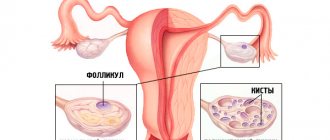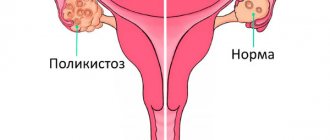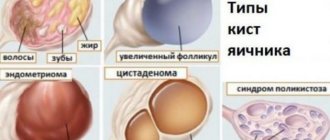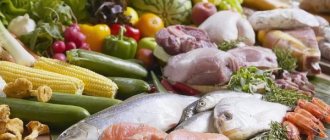» Weight loss » Diets » Diet for polycystic ovary syndrome
0
367
Article rating
Polycystic ovary syndrome is a fairly common disease of the genital area. The causes of this disease must be sought in the woman’s hormonal background, in disturbed metabolism. Statistics show that about 20% of women suffer from this disease.
To treat polycystic disease, an integrated approach is required. The diet for polycystic ovary syndrome is very good at the early stage of the disease.
Why is polycystic disease dangerous?
Sometimes women treat this disease quite frivolously and in vain. The sooner you start treating it, the greater your chances of avoiding complications. Polycystic disease can lead to the development of obesity and diabetes.
The goal of treating this disease is to restore female fertility, and it is important to achieve long-term rather than short-term results. For this purpose, means are selected that help to establish the metabolic process in a woman’s body.
This is important to do because obesity and diabetes are nothing more than a consequence of metabolic imbalance and hormonal imbalance.
Why is a diet needed?
A diet for polycystic ovary syndrome is needed as a therapeutic way to restore hormonal levels and metabolism. If the diet goes against the medications, then the ultimate goal, restoring fertility, will be more difficult to achieve.
It must be said that among patients who suffer from polycystic disease there are often overweight women. And the first thing a competent gynecologist talks about in this case is the patient’s weight loss.
Of course, we cannot talk about strict diets or express diets here. Such methods will only put the body into even more stress and completely disrupt hormonal cycles. Here we are talking about proper balanced nutrition, which brings the body into a state of peace.
What are the basic principles on which the diet for polycystic ovary syndrome is based?
How does diet help with polycystic disease?
The main stage of treatment for polycystic ovary syndrome is the fight against obesity. In the body of a sick woman, the production of estrogen and androgens increases. Additional amounts of these substances are formed in lipid tissues. Reducing fat mass normalizes hormonal balance and carbohydrate metabolism. The symptoms of polycystic disease disappear - the menstrual cycle normalizes, ovulation appears.
Why is it difficult to lose weight with polycystic disease?
The disease is characterized by a number of processes that make weight loss difficult. Reasons include:
- Insulin resistance - fat deposits form in the abdominal area due to the lack of absorption of the hormone by the body's cells.
- Metabolic slowdown.
- Malfunction of the hormones ghrelin and leptin - these substances are responsible for the feeling of hunger.
Fractional meals
The human body experiences great stress when a person alternates between overeating and undereating. In the case of a fast, the body tries not to use up reserves and metabolism slows down. When a person overeats, the body simply does not have time to process the received food into energy. This all leads to stress, which also affects hormonal levels.
It is very important to eat fractionally, when you eat small portions, three to four times a day. This is a wonderful prevention for diabetes and getting rid of extra pounds.
Also, in this case, the principle “do not eat after six o’clock in the evening” is not appropriate. This principle is only appropriate if you go to bed at 9-10 pm. If you go to bed at 11 or 12 at night, then a light snack at 8 pm is quite justified.
Doctors prescribe the following diet for patients with polycystic disease:
- The best way to start your day is with one or two glasses of water on an empty stomach. In cold weather, you can heat some water and add a slice of lemon and a drop of honey.
- Then, after 40-50 minutes, you need to have a tasty and hearty breakfast.
- After 2-3 hours you can have a light snack, great if it’s your favorite fruit.
- At lunchtime, also eat a hearty and tasty meal, the basis of your lunch is protein.
- For dinner, eat a small portion of your favorite dish. In the evening, it is important to treat yourself to your favorite dish, but the portion should be very small.
- A few hours before bed, drink herbal tea with a couple of cookies, a glass of kefir or fresh vegetable juice.
This diet for polycystic ovary syndrome will bring your body into psychological comfort . The body will begin to believe that you care about it, and from this it will begin to recover.
Low-calorie food
Everyone knows that if you eat high-calorie foods constantly, this leads to excess weight. Therefore, it is important for patients with polycystic ovary syndrome to monitor the calorie content of their meals. The second rule on which the diet for polycystic ovary syndrome is based is to choose foods whose glycemic index does not exceed 50 units. This restriction is necessary to ensure that the body maintains the required level of blood sugar.
What products are subject to this restriction:
- Fish, seafood, including seaweed, shrimp, mussels.
- Lean meats: rabbit, lean beef, veal, turkey, chicken, sometimes lean pork if you like it.
- Pasta made from durum wheat.
- Wholemeal bread.
- Mushrooms.
- Legumes: peas, lentils, red and white beans, chickpeas.
- Dairy and fermented milk products with medium fat content, cottage cheese, kefir, starter cultures, natural yoghurts.
- All types of vegetables, especially pay attention to green vegetables, lettuce leaves, cucumbers, all types of cabbage, they have a very beneficial effect on women's health.
- Fresh fruits and berries. Try to eat them raw, as they retain more nutrients.
- Seeds and nuts of different types. They contain healthy fatty acids, but they are high-calorie foods, so they should be eaten in limited quantities.
- Unrefined vegetable oil. Sunflower, pumpkin, sesame, flaxseed, nut, a couple of spoons are good to add to fresh vegetable salads.
- Dried fruits are also useful. These are dried apricots, figs, raisins, prunes.
As you can see, the list of products is extensive, so a diet for polycystic ovary syndrome involves preparing many tasty and healthy dishes.
Artificial sweeteners and alcohol
Artificial sweeteners are often found in “diet” foods, but that doesn’t mean they are healthy foods. Natural sweeteners are the best choice, if you are really looking for something to sweeten your food, you can use stevia and xylitol, for example.
It has been proven that insulin receptors are found in the ovaries as a result of consuming large amounts of sugars, alcohol and refined carbohydrates, which leads to increased insulin secretion and the production of too many androgens through the ovaries. As a result, this leads to hormonal imbalances that can negatively affect fertility.
What are the benefits of lifestyle changes?
Most cases of infertility due to ovulation disorders can be prevented by changing your lifestyle. Modification of one of the following factors may increase fertility in PCOS.
- reduce the consumption of trans fats, switch to foods higher in monounsaturated fats;
- consume foods rich in fiber more often;
- give preference to foods with a low glycemic index;
- eating foods that are good sources of iron;
- add multivitamin supplements.
Increase the proportion of dietary fiber in your diet. This is important for women with polycystic ovary syndrome because it regulates carbohydrate metabolism. Fiber limits the access of hydrolytic enzymes to sugars in the digestive tract. This prevents a sharp increase in blood glucose levels, which indirectly also affects the normalization of insulin secretion.
Sources of dietary fiber are:
- vegetables: beans, Brussels sprouts, green beans, green peas, cabbage, carrots and parsley;
- legumes: beans, peas, lentils and soybeans;
- fruits: raspberries, black and red currants, gooseberries, avocado, blueberries, pears, apples, kiwi;
- whole grains: whole grain bread, unsweetened cereal, wholemeal pasta and brown rice.
Limit simple carbohydrates and replace them with low glycemic index carbohydrates. They gently increase glucose and insulin concentrations after meals. Carbohydrates with a low glycemic index usually have a higher dietary fiber content. Consume whole grain cereals, cereals (buckwheat, barley), unsweetened cereal (oatmeal, barley), brown rice and whole wheat pasta cooked until al dente.
Limit your fat intake
The menu for this disease necessarily limits the consumption of animal fat. Animal fat in large quantities negatively affects liver function. With such a disease, the liver already suffers from excess load due to hormonal imbalance. So, you need to forget about fatty meat and lard . But you won’t have to give up fatty fish like salmon and trout. The fact is that such fish contains useful polyunsaturated acids, which are very necessary for the body, especially for women.
Maintain a balance between carbohydrates and proteins
The diet for polycystic ovary syndrome involves a balanced intake of proteins and carbohydrates. Carbohydrates, like proteins, must be correct. You need to forget about fast harmful carbohydrates, which include: all confectionery products, white sugar, baked goods made from premium flour, jam, jam . We are talking about the right carbohydrates - cereals, fruits, and a very limited amount of honey.
What is the glycemic index and why take it into account
A diet with a low glycemic index increases tissue sensitivity to insulin.
The glycemic index is the area under the glycemic curve after the body processes a serving of food. In other words, this is the effect of carbohydrates on changes in blood glucose. A lower index means a lower glycemic rise. Another GI-related metric is the glycemic load, which is the product of the glycemic index and the carbohydrate content of a portion of the food.
White flour has a high glycemic index, so replace it with: whole grain bread, buckwheat, chia or other large grain cereals. It's important to note that you can eat buckwheat if you have PCOS because it's a well-balanced meal.
Glycemic index of fruits
Not all fruits have a low glycemic index. Not only the index is important, but also the glycemic load.
How to calculate the glycemic load of fruits?
GL = glycemic index of a given product X amount of carbohydrates (g) / 100
Examples: Banana 100 g = 72 (high index) x 22 g (carbs) / 100 = 15.84 (high limit) Watermelon 100 g = 75 (high index) x 8 g (carbs) / 100 = 6 (low)
What does it mean?
Absorption of watermelon carbohydrates occurs quickly (high rate), but their amount is very small, which should not cause an increased need for insulin. Therefore, the body will not have problems reducing the concentration of this hormone in the blood.
What about banana? The release of glucose after eating a banana occurs quickly (high index), since it has a lot of carbohydrates, which will increase blood glucose levels and “aggressive” insulin secretion. Therefore, people who have serious disorders associated with improper insulin should avoid fruits for a while.
The following foods should be avoided because they are usually sweetened:
- pineapples from a can;
- canned peaches;
- fruit juices (too much fructose for people with insulin resistance).
Particular attention should be paid to the method of preparing dishes. Raw carrots have a lower GI than cooked carrots. When it comes to high GI vegetables, it is recommended to calculate their glycemic load.
Should you give up pumpkin because of the glycemic index?
Glycemic load of 100 g pumpkin = 75 (index) x 7 (amount of carbohydrates) / 100 = 5.25 (low). What does it mean? Absorption of pumpkin carbohydrates occurs quickly (high rate of increase in glucose), but it contains very few carbohydrates, which should not cause an increased need for insulin.
Vegetables with a high index (this does not mean that you need to give them up forever).
- boiled carrots;
- boiled beets;
- potato;
- corn.
To prevent diabetes
To enhance diabetes prevention, it is important to saturate your menu with products that contain plant-type fiber. These are nuts, legumes, green vegetables. These foods help reduce harmful cholesterol levels in the blood. Natural products
With polycystic ovary syndrome, it is important to give preference to farm products. Products purchased at the supermarket contain more antibiotics and chemicals than those you buy from a farmer . However, in the case of dairy products, it is perhaps worth giving preference to store-bought products, since they have undergone a pasteurelization process.
Eat fermented foods
Beneficial gut bacteria may play a role in metabolism and weight maintenance.
Research suggests that women with PCOS may have fewer beneficial gut bacteria than women without the condition (, , ).
In addition, new research shows that some probiotic strains may have a positive effect on weight loss ().
Therefore, eating foods high in probiotics, such as yogurt, kefir, sauerkraut, and other fermented foods, can help increase the number of beneficial bacteria in your gut.
You can also try taking probiotic supplements to get the same results.
Summary:
Women with PCOS may have lower amounts of beneficial gut bacteria. Eating foods rich in probiotics or taking probiotic supplements can support your gut bacteria, thereby promoting weight loss.
List of foods you shouldn't eat
If you have polycystic ovary syndrome, then you will have to forget once and for all about foods that contain a lot of carbohydrates or cholesterol. This is an important rule that cannot be broken. The fact is that if you follow your taste and continue to eat these foods, then you will negate all the drug treatment prescribed by your doctor. This threatens a new disruption in metabolism. What foods should you not eat if you have this disease?
- I'm eating from fast food. This doesn't just include McDonald's food. These include fried pies, sandwiches with sausage and mayonnaise, various bars, all street food.
- Sausages.
- Smoked products.
- Butter, margarine, lard.
- Harmful sauces based on mayonnaise, ketchup.
- Semi-finished products.
- Breadcrumbs.
- Alcoholic drinks.
- Sweet carbonated drinks
- Coffee, strong black tea.
- Jam, honey in large quantities.
- Products that contain large quantities of starch: potatoes, rice, semolina, corn.
- Berries and fruits with little fiber are watermelon, persimmon, melon.
Forming new habits
Women who have this disease must understand that this is not a death sentence. Correctly prescribed treatment, where o . Over time, the functioning of the thyroid gland and gonads will be restored, which means that the hormonal balance will be restored in general.
Think of it not as a treatment, but as a transition to a healthier lifestyle. By the way, if you didn’t have competent physical activity in your lifestyle before, then introduce it into your life now. Sport also affects hormonal levels.
Be happy to replace all past bad habits with new good ones. Learn to make salads not with mayonnaise, but with lemon juice and vegetable oil. Replace your favorite confectionery with delicious nuts and seeds. It's all a matter of habit. And a habit can always be formed if you understand the importance of the task.
Reduce inflammation
Inflammation is your body's natural response to infection or injury.
But chronic inflammation, which is common in women with PCOS, is associated with obesity. Sugar and processed foods can contribute to inflammation ().
In one study, 16 women with PCOS who took a single 75g dose of glucose—a special type of sugar—had higher levels of inflammatory markers in their blood compared to women without the condition ().
A Mediterranean-like diet high in fruits, vegetables, whole grains, olive oil, and foods rich in omega-3 fatty acids such as fatty fish may protect against inflammation ().
Summary:
Inflammation is common in women with PCOS and is associated with obesity. Eating a diet high in whole foods, especially fruits and vegetables, may protect against inflammation.
Sample menu for the week
Taking into account all the rules described above, we present an approximate menu for a week for polycystic ovary syndrome:
- First day:
- Don't forget to drink a glass or two of drinking water every morning on an empty stomach.
- In the morning: wholemeal toast, steamed cutlet, cup of tea.
- Snack: Your favorite fruit.
- In the afternoon: lean borscht, a piece of boiled chicken.
- In the evening: baked piece of salmon, fresh cucumber salad.
- Vegetable juice at night.
- Second day:
- In the morning: low-fat cottage cheese with parsley and salt, two wholemeal toasts, green tea.
- Snack: your favorite fruit or 20 grams of your favorite nuts.
- In the afternoon: soup with minced chicken meatballs, tomato and cucumber salad.
- In the evening: salad of sauerkraut, fresh carrots and onions, seasoned with vegetable oil.
- A glass of kefir at night.
- The third day:
- In the morning: oatmeal, half a grapefruit, green tea.
- Snack: Your favorite fruit.
- In the afternoon: fish soup, minced beef cutlet.
- In the evening: vegetable and chicken stew.
- Herbal tea at night.
- Fourth day:
- In the morning: buckwheat with steamed cutlet, a cup of tea.
- Snack: Your favorite fruit.
- In the afternoon: cabbage soup with sauerkraut, cutlet baked in the oven.
- In the evening: low-fat cottage cheese casserole, weak black tea.
- Fifth day:
- In the morning: toast, a piece of hard low-fat cheese, a cup of tea.
- Snack: pea soup, a piece of trout baked in the oven.
- In the evening: roast turkey, tea.
- Herbal tea at night.
- Sixth day:
- In the morning: wholemeal toast, 50 grams of low-fat cottage cheese with parsley, salt and black pepper.
- Snack: dried fruits.
- In the afternoon: steam cutlet, pea soup.
- In the evening: low-fat cottage cheese casserole.
- Kefir at night.
- Seventh day:
- In the morning: buckwheat, a piece of low-fat hard cheese, tea.
- Snack: Favorite fruit.
- In the afternoon: lean borscht, steamed cutlet.
- In the evening: chicken stew, tea.
- Kefir at night.
This is a sample menu for every day, experiment with dishes, taking into account all the rules. Reviews say that with polycystic disease you can come up with many delicious dishes. The same diet should be followed every day by patients who have polycystic ovary syndrome, when there is no cyst yet, but the menstrual cycle and ovulation have already been disrupted. This kind of polycystic ovary syndrome is a warning from the body, don’t ignore this syndrome, eat right.











